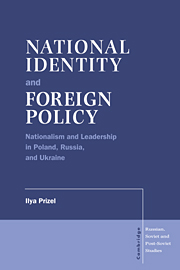Book contents
- Frontmatter
- Contents
- Preface
- Introduction: statement of arguments
- 1 National identity and foreign policy: a dialectical relationship
- 2 Polish identity 1795–1944: from romanticism to positivism to ethnonationalism
- 3 Poland after World War II: native conservatism and the return to Central Europe
- 4 Polish foreign policy in perspective: a new encounter with positivism
- 5 Russia's national identity and the accursed question: a strong state and a weak society
- 6 Russian identity and the Soviet period
- 7 Russia's foreign policy reconsidered
- 8 Ukraine: the ambivalent identity of a submerged nation, 1654–1945
- 9 Ukraine after World War II: birth pangs of a modern identity
- 10 Foreign policy as a means of nation building
- 11 Conclusion: national identity and politics in the age of the “Mass-Man”
- Index
- Cambridge Russian, Soviet and Post-Soviet Studies
10 - Foreign policy as a means of nation building
Published online by Cambridge University Press: 18 December 2009
- Frontmatter
- Contents
- Preface
- Introduction: statement of arguments
- 1 National identity and foreign policy: a dialectical relationship
- 2 Polish identity 1795–1944: from romanticism to positivism to ethnonationalism
- 3 Poland after World War II: native conservatism and the return to Central Europe
- 4 Polish foreign policy in perspective: a new encounter with positivism
- 5 Russia's national identity and the accursed question: a strong state and a weak society
- 6 Russian identity and the Soviet period
- 7 Russia's foreign policy reconsidered
- 8 Ukraine: the ambivalent identity of a submerged nation, 1654–1945
- 9 Ukraine after World War II: birth pangs of a modern identity
- 10 Foreign policy as a means of nation building
- 11 Conclusion: national identity and politics in the age of the “Mass-Man”
- Index
- Cambridge Russian, Soviet and Post-Soviet Studies
Summary
The collapse of the Soviet Union and Ukraine's subsequent attainment of independence may well prove to be the most propitious developments in Eastern European history since the collapse of the Ottoman, German, and Habsburg empires after World War I. Unlike the disintegration of the older empires, which occurred after four years of war, the recent proliferation of East European states was the result of the sudden Soviet implosion. Almost overnight, Ukraine was transformed from a compliant fiefdom of the Communist Party of the Soviet Union and its Ukrainian satrapies into one of Europe's largest states, located between a disgruntled Russia and an enlarging NATO. And unlike the post-Versailles states, which basked in the glow of international attention, Ukraine's independence went almost unnoticed by the international community. Although such countries as Hungary, Poland, and Canada quickly recognized Ukraine's independence, the United States and Germany first tried to breathe life into the faltering Soviet Union and then focused on Russia. Both the suddenness and remoteness of Ukraine's independence complicated its sense of nationhood.
This rapid metamorphosis deprived Ukraine of several vital building blocks of nation building. Because of its peaceful, almost uneventful transformation, Ukraine lacked a unifying national mythology and heroes. Although some nationalists called for a new, distinct Ukrainian political and cultural awareness, especially in foreign affairs and language policy, most Ukrainians found this agenda unappealing. Furthermore, Ukrainians could neither look to a common national experience for a “usable past” nor follow Israel's example and use their own experience of genocide (The Great Famine) as a nation-defining experience because, in George Grabowicz's words, “the perpetrators of its [Ukraine's] former suppression, and at the very least the co-conspirators of this policy [of suppression], are still part of the establishment.”
- Type
- Chapter
- Information
- National Identity and Foreign PolicyNationalism and Leadership in Poland, Russia and Ukraine, pp. 372 - 403Publisher: Cambridge University PressPrint publication year: 1998



